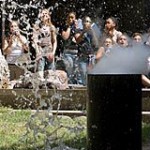Category Science & Technology
Friends, colleagues remember the late Denice Denton
When Denice Denton arrived at the University of Wisconsin–Madison in the winter of 1987, she was the lone female faculty member in the College of Engineering. Nine years later, she left the university an internationally recognized researcher, teacher, mentor and, above all, champion of the underdog and on her way to becoming the first female engineering dean at a major research university.
UW-Madison receives academic technology excellence award
The University of Wisconsin–Madison has been named as a 2007 Center of Excellence, the highest honor bestowed by the national New Media Consortium (NMC). The award recognizes UW–Madison's demonstrated excellence and outstanding achievement in the application of technology to learning or creative expression.
Curiosities: Why do flowers smell, and why do plants smell, too?
The luscious aroma of flowers attracts lovers, and the biological role of that smell is similar: to attract pollinators. “Plants need to attract insects,…
Synthetic garnets made by Chancellor Wiley displayed at Geology Museum
In a small, freestanding case near the entrance of the University of Wisconsin–Madison Geology Museum, you might notice a familiar name next to two faintly yellow gems.
UW-Madison shares in national IT award
An information technology project in which the University of Wisconsin–Madison played a key role is the winner of a major award for excellence.
Curiosities: How well do dogs see at night?
A lot better than we do, says Paul Miller, clinical professor of comparative ophthalmology at University of Wisconsin–Madison. “Dogs have evolved…
Fifty years and counting: The Wisconsin Longitudinal Study
Lee Schoenecker doesn't recall filling out a survey 50 years ago about his plans after high school, yet this long-forgotten event has stayed with him ever since. Because of it, the retired urban planner has spent many more hours being surveyed both by telephone and written questionnaire. He recently provided a sample of DNA. Even his wife and siblings have become involved.
WLS: The long-term study that almost wasn’t
It's now one of the longest social science investigations ever. Yet, at the beginning, the Wisconsin Longitudinal Study (WLS) wasn't meant to last.
Recent sightings: Science learning with a big bang
A group of high school students from the univeristy’s Pre-college Enrichment Opportunity Program for Learning Excellence (PEOPLE) react to the big…
Researchers studying fantasy baseball and ‘competitive fandom’
Erica and Rich Halverson aren't just spending the summer running their fantasy baseball teams. The University of Wisconsin–Madison assistant professors are also studying fantasy leagues, including their own, in a new research project aimed at understanding how both expert and novice players approach the game and what it can teach us about how people learn.
Study finds variable drug sensitivity among hepatitis C viruses
A new study from the University of Wisconsin–Madison School of Medicine and Public Health offers promise for a double-duty treatment that may provide both immune suppression and anti-HCV activity in a single drug.
Catching the insect bug: Insect Ambassadors spread their fascination with the six-legged world
When he was in seventh grade, Mike Hillstrom was happiest when he was playing with bugs. A dozen years later, it's still true. But now the bugs are a lot bigger and more exotic. And technically, he's not just playing.
Statement on NBAF short list announcement
Chancellor John D. Wiley expresses diappointment with the decision of the U.S. departments of Homeland Security and Agriculture to not include Wisconsin on its list for consideration for the National Bio- and Agro-defense Facility (NBAF).
Soil particles found to boost prion’s capacity to infect
The rogue proteins that cause chronic wasting disease (CWD) exhibit a dramatic increase in their infectious nature when bound to common soil particles, according to a new study.
Bacteriologist tabbed for prestigious NIH research award
Richard L. Gourse, a professor of bacteriology at the University of Wisconsin–Madison and an expert on the critical early steps of gene expression, has received a prestigious MERIT award from the National Institutes of Health, which provides research funding for up to 10 years.
Curiosities: What is the surface of the Sun like?
“Technically, there is no surface of the Sun,” says UW–Madison’s Sanjay Limaye. The senior scientist and educator with the Space…
Mother-of-pearl: Classic beauty and remarkable strength
While the shiny material of pearls and abalone shells has long been prized for its iridescence and aesthetic value in jewelry and decorations, scientists admire mother-of-pearl for other physical properties as well.
Curiosities: After rains, why do worms crawl out onto the pavement and “commit suicide”?
After a strong rain, the corpses of worms strewn across the pavement are a disgusting sight – or a pathetic one, depending on your…









